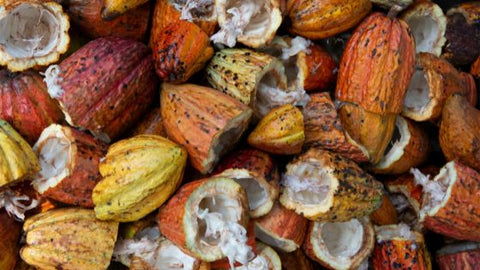Chocolate is a treat beloved around the world — the silky mouthfeel and sweet taste are a combination that’s hard to beat. When it comes to food, it’s one of the most ubiquitous flavors, likely because anyone can enjoy it no matter their age. It’s no surprise that it’s one of the most widely-consumed products in the world.
However, there’s a flip side to its popularity that many don’t realize. The staggering global demand requires a staggering global production, yet over the next 30 years, the areas suitable for producing cocoa are predicted to shrink by 20% to 30%. This presents a worrying future for chocolate lovers everywhere. But it’s not an entirely hopeless situation just yet.
Thanks to efforts from organizations like the World Cocoa Foundation, the Rainforest Alliance, and One Tree Planted, the cocoa industry is slowly building up the necessary programs and protection to save cocoa. To learn more about the solutions they are implementing, namely agroforestry, check out the rest of the article.
The Impact of Climate Change on the World’s Cocoa Production
First off, it’s important to understand why cocoa growing communities are currently facing a bleak future. Chocolate comes from the fruit of the cocoa tree, which is traditionally grown under the diverse and dense canopies of shade trees. Right now, over 60% of all the chocolate enjoyed in the world is produced by smallholder farmers in Ghana, Côte d'Ivoire, and Indonesia. Due to the high global demand for chocolate, these smallholder farmers use a system called “full sun cocoa production” to pump out higher yields. This practice involves constantly expanding cocoa-planting areas, reducing shade trees, and increasing the use of chemical fertilizers and pesticides.
While these techniques do lead to higher yields, they’ve also resulted in many negative environmental side effects — more frequent outbreaks of diseases and pests, loss of biodiversity, deforestation, and poor ecosystem properties. These effects, combined with rising global temperatures and extreme weather events from climate change, lead to smallholder farmers producing less cocoa per unit area on their farms. In addition, the negative effects left behind by current cocoa production practices lead to less and less available area for farming.
How Sustainable Farming and Agroforestry Can Help
According to a report by the Rainforest Alliance, sustainable cocoa production faces four challenges:
- Loss of natural ecosystems on and near cocoa farms — Due to the reduction of shade trees for cocoa farms, many forest-dwelling plants and animals suffer a loss of habitat.
- Low farm productivity — Smallholder farmers face the problem of diseases and pests, aging cocoa trees, and insufficient pruning.
- Entrenched poverty — Many cocoa farms are located in Africa, the poorest continent in the world. Regrettably, many unfavorable labor practices still occur due to this, namely child labor in some regions.
- Exposure to hazardous agrochemicals — These chemicals pose a danger not only to the environment but also to the farmers who may lack protective equipment or knowledge of proper application and storage.
To address these challenges, many members of the chocolate industry are taking an interest in agroforestry. Agroforestry is the practice of planting (or managing the regeneration of) companion shade trees alongside cocoa. It comes with several key benefits that can put the cocoa industry on a brighter path forward.
The Benefits of Agroforestry for the Chocolate Industry
Here are some of the main benefits of agroforestry:
Empowering Cocoa Growing Communities To Produce Higher Income
The standard set by the Sustainable Agriculture Network (SAN) calls for at least 12 trees per farm hectare, 40% shade cover, and two layers of vertical canopy cover. It also has criteria for protecting the natural ecosystems and buffer areas around bodies of water.
This means that a healthy cocoa growing system features various other plant species, which can include timber trees, food trees (which produce nuts, fruits, vegetables, and oils), food plants, and medicinal plants. The yield from these additional plant species can allow cocoa growing communities to diversify their income.
Securing Household Food and Nutrition Needs
As mentioned above, the companion plants for cocoa production can include food-producing trees and plants. Cocoa farmers can also use these plants to meet their household food needs, reducing their cost of living.
Restoring Biodiversity
When farmers expand into neighboring forests or remove native tree species from their farms, the surrounding ecosystem suffers the loss greatly. By replanting trees, cocoa farmers can rebuild connectivity in crop areas, increase tree species diversity, reduce pest and disease outbreaks, and promote higher crop yields.
Protecting the Environment
More trees mean better soil health, nutrient flow, and pollination. These are all positives for cocoa farms and their local area. However, more trees also make a difference on a worldwide scale — better carbon sequestration means less carbon and other greenhouse gasses trapped in our atmosphere. These gasses are the cause of climate change.
Currently, the effects of climate change are already being felt around the globe but they still have the potential to get worse. This makes eliminating carbon an incredibly important directive for the world at large. Luckily, it’s a directive that cocoa farms can directly contribute to through agroforestry.
How One Tree Planted Is Making a Difference
Ghana, located in West Africa, is the world’s second-largest cocoa producer yet it suffers heavily from deforestation. By 2016, the country had lost 80% of state-managed forests due to illegal logging. Worse still, from 2017 to 2018, the country saw a 60% increase in forest loss. The effects of this deforestation are widespread and rampant — previously productive agricultural soil turns into sand and the increased soil erosion reduces the quality and quantity of their water supplies.
To address this crisis, the Ghanaian government pledged to stop deforestation in their cocoa industry and launched the Green Ghana Initiative dedicated to planting trees.
In 2019, One Tree Planted successfully planted 25,000 trees in northern Ghana. This success was achieved through partnerships with the Ghanian Environmental Protection Agency (EPA) and roughly 300 local volunteers. When these trees are fully grown, they will enhance both the health of the soil and the lives of the people nearby. They can increase the quality of water supplies, provide much-needed vegetal cover, and reduce soil erosion, allowing other native plant species to flourish and cocoa growing communities to prosper. This will be the beginning of a positive, regenerative feedback loop that will hopefully continue well into the future.
Take Part in Planting for the Future of Cocoa With Your Next Order
At Chocolate & More Delights, we understand the importance of looking towards the future. We want to continue providing you with sustainable and fair-trade, artisan, organic chocolate for years to come, which is why we want to do our part for sustainable cocoa production. We actively support One Tree Planted through our online store — with every order, you too can plant a tree through One Tree Planted. Place an order today at www.chocolateandmoredelights.com and join us in planting trees to save cocoa!
Like it? Share it!




